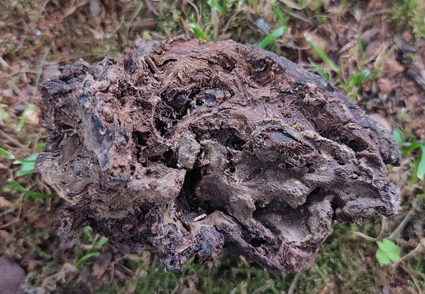Abstract
A wood-inhabiting fungal species, Physisporinus yunnanensis is proposed based on a combination of morphological features and molecular evidence. Physisporinus yunnanensis is characterized by annual, resupinate, bone-hard basidiomata with an olivaceous to black pore surface, a monomitic hyphal system, presence of hyphoid cystidia at dissepiment edge and subglobose, smooth basidiospores measuring as 4–5.5 × 3.5–5 µm, and causing a white rot. The phylogenetic analyses based on molecular data of ITS+nLSU sequences showed that P. yunnanensis is sister to P. furcatus with high support (100% BS, 100% BP, 1.00 BPP). Both morphological characteristics and molecular phylogenetic analyses confirmed the placement of the new species in Physisporinus.
References
Chen, J.J. & Dai, Y.C. (2021) Two new species of Physisporinus (Polyporales, Basidiomycota) from Yunnan, Southwest China. Mycological Progress 20: 1–10. https://doi.org/10.1007/s11557-020-01647-8.
Dai, S.J. & Dai, Y.C. (2018) Morphological characters and molecular data reveal a new species of Physisporinus (Basidiomycota) from Southeast Asia. Mycosystema 37: 145–150. https://doi.org/10. 13346/j.mycosystema.170210
Dai, Y.C. (1998) Changbai wood-rotting fungi 9. Three new species and other species in Rigidoporus, Skeletocutis and Wolfiporia (Basidiomycota, Aphyllophorales). Annales Botanici Fennici 35: 143–154.
Decock, C. & Ryvarden, L. (2021) Aphyllophorales of Africa 48 some poroid species from São Tomé. Synopsis Fungorum 44: 14–18.
Felsenstein, J. (1985) Confidence intervals on phylogenetics: An approach using bootstrap. Evolution 39: 783–791. https://doi.org/10.1111/j.1558-5646.1985.tb00420.x
Fisher, A.B. & Fong, S.S. (2014) Lignin biodegradation and industrial implications. AIMS Bioengineering 1: 92–112. https://doi.org/10.3934/bioeng.2014.2.92
Gilbertson, R.L. & Ryvarden, L. (1987) North American Polypores Vol. 2. Megasporoporia-Wrightoporia. pp. 437–885.
Hall, T.A. (1999) BioEdit: a user-friendly biological sequence alignment editor and analysis program for Windows 95/98/NT. Nucleic Acids Symposium Series 41: 95–98.
Hjortstam, K. & Ryvarden, L. (1980) Studies in tropical Corticiaceae (Basidiomycetes). II. Mycotaxon 12: 168–184.
Ipulet, P. & Ryvarden, L. (2005) New and interesting polypores from Uganda. Synopsis Fungorum 20: 87–99.
Karsten, P.A. (1889) Kritisk öfversigt af Finlands Basidsvampar (Basidiomycetes; Gastero- & Hymenomycetes). Bidrag till Kännedom av Finlands Natur och Folk 48: 1–470.
Marcot, B.G. (2017) A review of the role of fungi in wood decay of forest ecosystems. Res. Note PNW-RN-575.Portland, OR: US Department of Agriculture, Forest Service, Pacific Northwest Research Station 575: 1–31.
Miettinen, O., Larsson, E., Sjokvist, E. & Larsson, K.H. (2012) Comprehensive taxon sampling reveals unaccounted diversity and morphological plasticity in a group of dimitic polypores (Polyporales, Basidiomycota). Cladistics 28: 251–270. https://doi.org/10.1111/j. 1096-0031.2011.00380.x
Miller, M.A., Pfeiffer, W. & Schwartz, T. (2012) The CIPRES science gateway: enabling high-impact science for phylogenetics researchers with limited resources. In Proceedings of the 1st Conference of the Extreme Science and Engineering Discovery Environment: Bridging from the extreme to the campus and beyond. pp. 1–8. https://doi.org/10.1145/2335755.2335836
Nakasone, K.K., Ortiz-Santana, B. & He, S.H. (2021) Taxonomic studies of crust fungi with spines in Radulomyces, Sarcodontia, and the new genus Noblesia. Mycological Progress 20: 1479–1501. https://doi.org/10.1007/s11557-021-01746-0
Niemelä T. (2005) Polypores, lignicolous fungi. Norrlinia 13: 1–320.
Núñez, M., Parmasto, E. & Ryvarden, L. (2001) New and interesting polypores from East Russia. Fungal Diversity 6: 107–114.
Núñez, M. & Ryvarden, L. (1999) New and interesting polypores from Japan. Fungal Diversity 3: 107–121.
Nylander, J.A.A. (2004) MrModeltest v.2. Program Distributed by the Author. Evolutionary Biology Centre, Uppsala University: Uppsala, Sweden.
Petersen, J.H. (1996) Farvekort. The Danish Mycological Society’s Colour-Chart. Foreningen til Svampekundskabens Fremme, Greve, Germany, pp. 1–6.
Ronquist, F., Teslenko, M., van der Mark, P., Ayres, D.L., Darling, A., Höhna, S., Larget, B., Liu, L., Suchard, M.A. & Huelsenbeck, J.P. (2012) MrBayes 3.2: efficient Bayesian phylogenetic inference and model choice across a large model space. Systematic biology 61: 539–542. https://doi.org/10.1093/sysbio/sys029
Ryvarden, L. & Johansen, I. (1980) A preliminary polypore flora of East Africa. Oslo, Fungiflora, Norway, 636 pp.
Ryvarden, L. & Melo, I. (2014) Poroid fungi of Europe. Synopsis Fungorum 31: 1–455.
Ryvarden, L. (1972) A critical checklist of the Polyporaceae in tropical East Africa. Norwegian Journal of Botany 19: 229–238.
Ryvarden, L. & Gilbertson, R.L. (1994) European polypores. Part 2. Synopsis Fungorum 7: 394–743.
Ryvarden, L. (2016) Neotropical polypores part 3. Polyporaceae, Obba-Wrightoporia. Synopsis Fungorum 46: 445–613.
Swofford, D.L. (2002) PAUP*: phylogenetic analysis using parsimony (*and other methods). Version 4.0b10. Sinauer Associates, Massachusetts.
Vampola, P. & Vlasák, J. (2012) Rigidoporus pouzarii, a new polypore species related to Rigidoporus crocatus. Czech Mycology 64: 3–11.
Wang, C.G. & Dai, Y.C. (2022) Phylogeny and taxonomy of Spongipellis (Polyporales, Basidiomycota) and its micromorphological similar genera. Mycological Progress 21: 1–18. https://doi.org/10.1007/s11557-022-01817-w
White, T.J., Bruns, T., Lee, S. & Taylor, J. (1990) Amplification and direct sequencing of fungal ribosomal RNA genes for phylogenetics. PCR protocols: a guide to methods and applications 18: 315–322. https://doi.org/10.1016/B978-0-12-372180-8.50042-1
Wu, F., Chen, J.J., Ji, X.H., Vlasák, J. & Dai, Y.C. (2017) Phylogeny and diversity of the morphologically similar polypore genera Rigidoporus, Physisporinus, Oxyporus, and Leucophellinus. Mycologia 109: 749–765. https://doi.org/10.1080/00275514.2017.1405215
Zhao, C.L., Cui, B.K. & Dai, Y.C. (2014) Morphological and molecular identifification of two new species of Hyphodontia (Schizoporaceae, Hymenochaetales) from Southern China. Cryptogam. Mycologie 35: 87–97. https://doi.org/10.7872/crym.v35.iss1.2014.87
Zhao, C.L. & Wu, Z.Q. (2017) Ceriporiopsis kunmingensis sp. nov. (Polyporales, Basidiomycota) evidenced by morphological characters and phylogenetic analysis. Mycological Progress 16: 93–100. https://doi.org/10.1007/s11557-016-1259-8
Zhou, M., Dai, Y.C., Vlasák, J. & Yuan, Y. (2021) Molecular phylogeny and global diversity of the genus Haploporus (Polyporales, Basidiomycota). Journal of Fungi 7: 96. https://doi.org/10.3390/jof7020096


